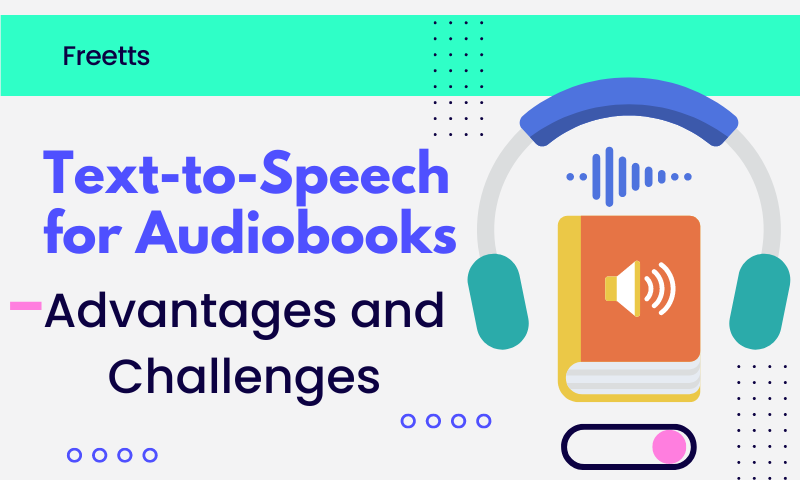Text-to-Speech for Audiobooks: Advantages and Challenges

What is Text-to-Speech?
Text-to-speech (TTS) technology converts written text into spoken words using synthetic voices. It employs advanced algorithms, artificial intelligence, and linguistic rules to produce human-like speech from text input.
Relevance and Importance of TTS in Audiobooks
The audiobook industry has seen exponential growth, driven by increased consumption of audio content. TTS technology offers significant potential in this space by providing scalable, cost-effective solutions for creating audiobooks, making literature more accessible to diverse audiences, including those with visual impairments or reading disabilities.
Relevance and Importance of TTS in Audiobooks
The audiobook industry has seen exponential growth, driven by increased consumption of audio content. TTS technology offers significant potential in this space by providing scalable, cost-effective solutions for creating audiobooks, making literature more accessible to diverse audiences, including those with visual impairments or reading disabilities.

Historical Context
Evolution of TTS Technology
From early mechanical attempts in the 18th century to modern AI-driven speech synthesis, TTS technology has undergone substantial advancements. Milestones include the development of IBM's Shoebox in the 1960s and the introduction of more natural-sounding voices in the 21st century.
TTS in the Audiobook Industry
Initially used for simple reading aids, TTS has evolved to produce full-length audiobooks. This transition reflects improvements in voice quality and the ability to capture the nuances of human speech, essential for narrating complex literary works.

Technical Specifications
Core Components of TTS Systems
TTS systems consist of text analysis, linguistic processing, and speech synthesis modules. Text analysis includes text normalization and tokenization. Linguistic processing involves phonetic and prosodic analysis, while speech synthesis converts linguistic data into audible speech.
Types of TTS Voices
- Concatenative Synthesis: Combines pre-recorded speech segments.
- Formant Synthesis: Uses mathematical models to create voices.
- Neural Network-based Synthesis: Employs deep learning for natural-sounding voices, as seen in technologies like WaveNet by Google.
Applications of TTS in Audiobooks
- Mainstream Publishing: Publishers leverage TTS to produce audiobooks quickly and cost-effectively, expanding their catalogues without the high costs associated with human narrators.
- Educational Materials: TTS audiobooks serve as invaluable tools in educational settings, providing access to textbooks and learning materials for students with disabilities or those learning new languages.
- Accessibility: For visually impaired users, TTS audiobooks offer a gateway to literature, enhancing their ability to consume and enjoy written works independently.

Comparative Analysis
TTS vs. Human Narrators
- Cost and Time: TTS is more cost-effective and faster to produce.
- Quality and Engagement: Human narrators excel in expressiveness and engagement.
- Flexibility: TTS offers consistent performance but may lack the unique touch of human interpretation.
TTS vs. Traditional Audiobook Production
Traditional production involves significant time and cost but results in high-quality, engaging narration. TTS offers scalability and speed, making it ideal for quick turnaround and lower-budget projects.
User Guides for TTS Audiobook Production
- Step 1: Visit the Freetts website and input the text you want to dub for TTS audiobooks into the conversion box. Choose the appropriate language from the options on the right side of the page. A silver color will appear beneath the selected language for further customization. You can preview each tone by clicking the green play icon next to it.

- Step 2: After selecting the desired tone, you'll find a "More Setting" option beneath the tone card on the right side. Click on it to adjust the audio format, quality, speed, volume, pitch, and pause time.

- Step 3: Once you’ve completed these adjustments, click "Convert Text to Speech." After conversion, if you'd like to save more characters using the Try Listen Mode, click on "Try Listen Mode. Only convert the first 50 characters." located in front of the switch.
- Step 4: If you're satisfied with the result, click the download icon to save it to your device.

The Advantages of Text-to-Speech for Audiobooks
Accessibility and Inclusion
TTS technology significantly enhances accessibility, making audiobooks available to individuals with visual impairments, learning disabilities, and other challenges that make reading difficult. By providing an alternative way to consume written content, TTS opens up the world of literature and information to everyone, promoting inclusivity.
Convenience and Multitasking
In our fast-paced lives, the ability to multitask is invaluable. TTS allows users to listen to audiobooks while commuting, exercising, or performing household chores. This convenience not only saves time but also enriches everyday activities by integrating continuous learning and entertainment.
Cost-Effectiveness
Producing traditional audiobooks can be costly, involving expenses for hiring professional voice actors, recording studios, and post-production editing. TTS technology offers a cost-effective alternative by automating the narration process. This reduction in production costs can lead to more affordable audiobooks for consumers and higher profit margins for publishers.
Rapid Production
TTS enables the swift production of audiobooks, as it eliminates the need for lengthy recording sessions and editing processes. Publishers can quickly convert new books into audiobooks, keeping up with market demand and releasing titles faster than ever before.

Challenges of Text-to-Speech for Audiobooks
Quality and Naturalness of Voice
One of the primary challenges with TTS is achieving a natural-sounding voice. Early TTS systems often produced robotic and monotonous speech, which detracted from the listening experience. While advancements in technology have significantly improved voice quality, creating a voice that fully captures the nuances and emotions of human narration remains a challenge.
Emotional Engagement
Human narrators bring stories to life with their ability to convey emotions and nuances in tone. TTS, despite its advancements, still struggles to match this level of emotional engagement. The lack of expressive intonation can make TTS-narrated audiobooks feel less immersive and engaging compared to those narrated by human voices.
Pronunciation and Context Understanding
TTS systems sometimes mispronounce words, especially names, and struggle with contextual understanding, leading to awkward or incorrect phrasing. These errors can disrupt the flow of the audiobook and detract from the listener’s experience. Continuous improvements in artificial intelligence and machine learning are necessary to address these issues effectively.

Future Prospects of TTS in Audiobooks
Advancements in AI and Machine Learning
The future of TTS in audiobooks is promising, driven by ongoing advancements in artificial intelligence and machine learning. Researchers are continually working on enhancing the naturalness of TTS voices, improving contextual understanding, and enabling better emotional expression. These improvements are set to bridge the gap between TTS and human narration, making TTS-narrated audiobooks more appealing.
Customization and Personalization
As TTS technology evolves, the ability to customize and personalize voices will become more prevalent. Users may soon have the option to choose from a variety of voices and accents, or even create bespoke voices tailored to their preferences. This level of personalization can significantly enhance the listener’s experience, making audiobooks more engaging and enjoyable.
Integration with Other Technologies
The integration of TTS with other emerging technologies, such as virtual reality (VR) and augmented reality (AR), holds exciting possibilities. Imagine listening to an audiobook in a VR environment where the surroundings change according to the story, creating a fully immersive experience. Such innovations could redefine how we consume audiobooks and other forms of digital content.

Conclusion
Text-to-speech technology has already made a substantial impact on the audiobook industry, offering numerous benefits such as accessibility, convenience, cost-effectiveness, and rapid production.
Despite challenges related to voice quality, emotional engagement, and pronunciation, continuous advancements in AI and machine learning promise a bright future for TTS in audiobooks. As this technology evolves, it will undoubtedly reshape the way we experience literature, making it more accessible and enjoyable for everyone.

